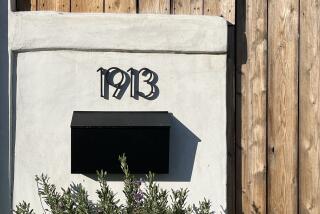How to Choose Between Old or New Neighborhood
- Share via
She’s a computer programmer and he’s a construction company supervisor.
Feeling cramped in their condo-apartment, the thirtysomething couple embarked with gusto on a house-hunting expedition. But they wrestled with one question.
Should they buy in an established neighborhood with a rich tradition or become pioneers in a faraway new-home nirvana?
In the end they selected the new tract, choosing a handsome contemporary with an oversized country kitchen.
Granted, the couple must travel many miles from their jobs. And they had to spend a small fortune on landscaping that the builder didn’t install. Still, they’re happy with their choice.
In their minds, the camaraderie with neighbors--mostly their age--is a plus. On summer evenings, the community is alive with kindred souls working in their yards, planting and pruning. They relish the esprit de corps.
“When you move into a new neighborhood, it’s like a club. Everybody is a transplant. And that puts everyone on the same level,” says Terri Murphy, a real estate agent and author of “Terri Murphy’s Listing & Selling Secrets,” a book by Dearborn Financial.
But new communities aren’t for everyone, real estate specialists say.
Some find the homogeneity of a new housing tract sterile and uninteresting. They miss the sense of history that comes with an older neighborhood, including the lore passed down by old-timers and the pleasure of holiday customs. Others resent the distance they must travel to reach most new-home havens.
Are you a home buyer uncertain whether an old or new neighborhood is your Shangri-La? If so, these five thoughts from real estate gurus could prove of value:
* No. 1: Ask yourself if you’d like a neighborhood inhabited by your age peers.
As a general rule, neighborhoods of middle-income homes attract young families with lots of school-age children, Murphy points out.
Wake up on Saturday mornings, and you’ll hear the rasping sound of preschoolers riding “big-wheelers” up and down driveways or older kids dribbling basketballs. The social life will probably be oriented to such child-related events as “play dates” and barbecues for kids’ baseball and soccer teams.
To some, a homogeneous, child-oriented neighborhood can seem oppressive, especially if nearly all the residents are dual-income couples with look-a-like schedules who always disappear during business hours.
Even for those with children, there can be comfort in having retired people around, if only because many are home during the day and that offers a measure of watchfulness, which makes the area seem more secure.
On the other hand, people in various demographic groups--singles, middle-aged empty-nesters or seniors--may prefer living with their peers. That explains the success of age-restricted active-adult communities around the United States, which cater to active seniors and offer their own senior support services and activities.
* No. 2: Recognize that life in a new-home community often comes with limits.
When a builder creates a subdivision, he typically draws up a list of limits that apply to those who buy in the neighborhood.
Known as “conditions, covenants and restrictions,” these rules can define anything from the color you’re allowed to paint your front door to whether you can hang your wash out to dry. One restraint that many new-home buyers find especially objectionable is the common rule against parking cars on the street in front of their homes, which puts a crimp in their party lives.
Are such limits a blessing or a curse?
Both, said Kenneth W. Edwards, a professor of real estate and the author of several books on the subject. They’re a blessing because they tend to uphold property values. But they’re a curse to rugged individualists who like greater control over their lives and property.
* No. 3: Factor in the hidden costs of buying into a brand-new community.
Buy into a new neighborhood and you can expect to spend 10% of the cost of the home to outfit the property during the first year you’re there, Murphy estimated.
It’s not only landscaping that most builders leave largely undone. A new home usually comes without such extras as a deck (unless you pay for the option). And the cost of new window coverings can add up quickly.
* No. 4: Examine carefully the guts of an older home.
New homes aren’t the only “money pits,” Edwards points out.
Older homes can be enormously costly, especially if a major system (plumbing, heating or air-conditioning) fails while you’re there. A new roof, exterior paint job or structural problem can also prove very costly.
Edwards worries about the aging of the American housing stock. Especially vulnerable, he said, are homes built right after World War II, when demand burgeoned.
Your best safeguard against purchasing a peck of costly problems is to have a serious home inspection before you finalize any purchase.
* No. 5: Consider a compromise between old and new neighborhoods.
Are you one who loves the variety, convenience and leafy beauty of a close-in suburb yet still wants the freshness and features of a brand-new home?
You might consider building a custom home on a spare lot in an old neighborhood.
Another alternative is to buy a nearly new home (say 2 to 3 years old) from a seller who has already invested substantial sums in landscaping, window coverings and other features. Or pick a new-home community where an environmentally sensitive builder has gone to special lengths to preserve greenery.
Many home buyers are torn between old and new and are surprised by the decision they ultimately make, according to Edwards.
“You have to be open-minded on the issue,” he said.
*
Distributed by Universal Press Syndicate.






